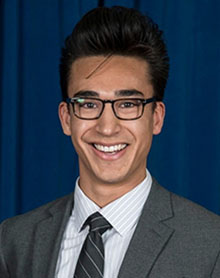The team of student intern Julian Vigil and mentor Tim Lambert (both 6124) has won a 2017 American Chemical Society (ACS) Division of Inorganic Chemistry Award for Undergraduate Research.

Julian will receive a financial stipend and a plaque; Tim will receive a plaque for permanent display at Sandia.
Julian’s research career began as a junior in high school, when he participated in an eight-week student-intern research program with Tim. During that Sandia program, called STAR (Science, Technology, And Research), Julian quickly learned to perform rotating-disk electrode studies. His results were significant enough to make him a co-author with Tim and a university professor on Julian’s first paper, submitted that summer and published Oct. 9, 2013. Since then, Julian has repaid Tim’s continued interest in his progress not only by mentoring newer students but by contributing to and then leading the development of a number of promising nanoscale inorganic electrocatalysts for oxygen electrochemistry and/or water-splitting. In addition to serving as models to understand the process of catalysis in systems of interest, Julian’s materials also have demonstrated excellent electrocatalytic activity and stability and hence are potentially a more cost-effective solution than the precious metals that are the current commercial standards.
Julian not only synthesized materials, evaluated their electrocatalytic performance, and performed background literature searches, he eventually — though still an undergraduate — wrote the main draft of five of his seven peer-reviewed publications in Electroanalysis, Journal of Physical Chemistry C, Chemical Communication, ACS Applied Materials & Interfaces, RSC Advances, and Journal of Materials Chemistry A, with Julian serving as first author on three of them. Two more manuscripts, all with Tim, are currently in preparation. The paper from his high school years has been cited at least 33 times; his undergraduate work has received 61 additional citations.
Meanwhile, Tim — in addition to mentoring Julian to become a productive independent researcher in the laboratory — has also educated him on professional aspects of science. These include how to present at national meetings, the importance of aiding in peer review, maintaining proper laboratory ES&H documentation, inventorying chemicals, and more.
Prior evidence of the strength of Julian’s academic talents, combined with Tim’s comprehensive educational research program, was demonstrated by Julian’s recent designation as a 2016 Barry Goldwater Scholar. He has also been named a 2017 Churchill Scholar and will study at Cambridge University in the UK.
“The tailoring of our program to fit Julian’s part-time schedule is helping him to succeed and develop as a scientist,” Tim says.
?The joint ACS award will be presented at the organization’s national meeting in San Francisco, held April 2-6. As part of his award, Julian will give an invited talk during the Inorganic Division-sponsored “Frontiers in Undergraduate Research” symposium. Julian’s talk is titled “Advances in Manganese- and Cobalt-based Nanostructures for Oxygen/Hydrogen Electrocatalysis.”

Julian Vigil wins Churchill Scholarship
Julian Vigil, a Sandia student intern and University of New Mexico chemical engineering student, has just been awarded a Churchill Scholarship, named in honor of the famed World War II-era British prime minister. The program chooses 14 students to study at the University of Cambridge in England for a one-year master’s degree program.
According to the Churchill Scholarship website, “The Foundation’s Scholarship Program offers American citizens of exceptional ability and outstanding achievement the opportunity to pursue graduate studies in engineering, mathematics, or the sciences at Cambridge.”
Says Julian, “A lot of work in my studies and research made me competitive for the scholarship, but I also owe a lot of the credit to the many great mentors I’ve had in the faculty at UNM and the technical staff at Sandia Labs.”